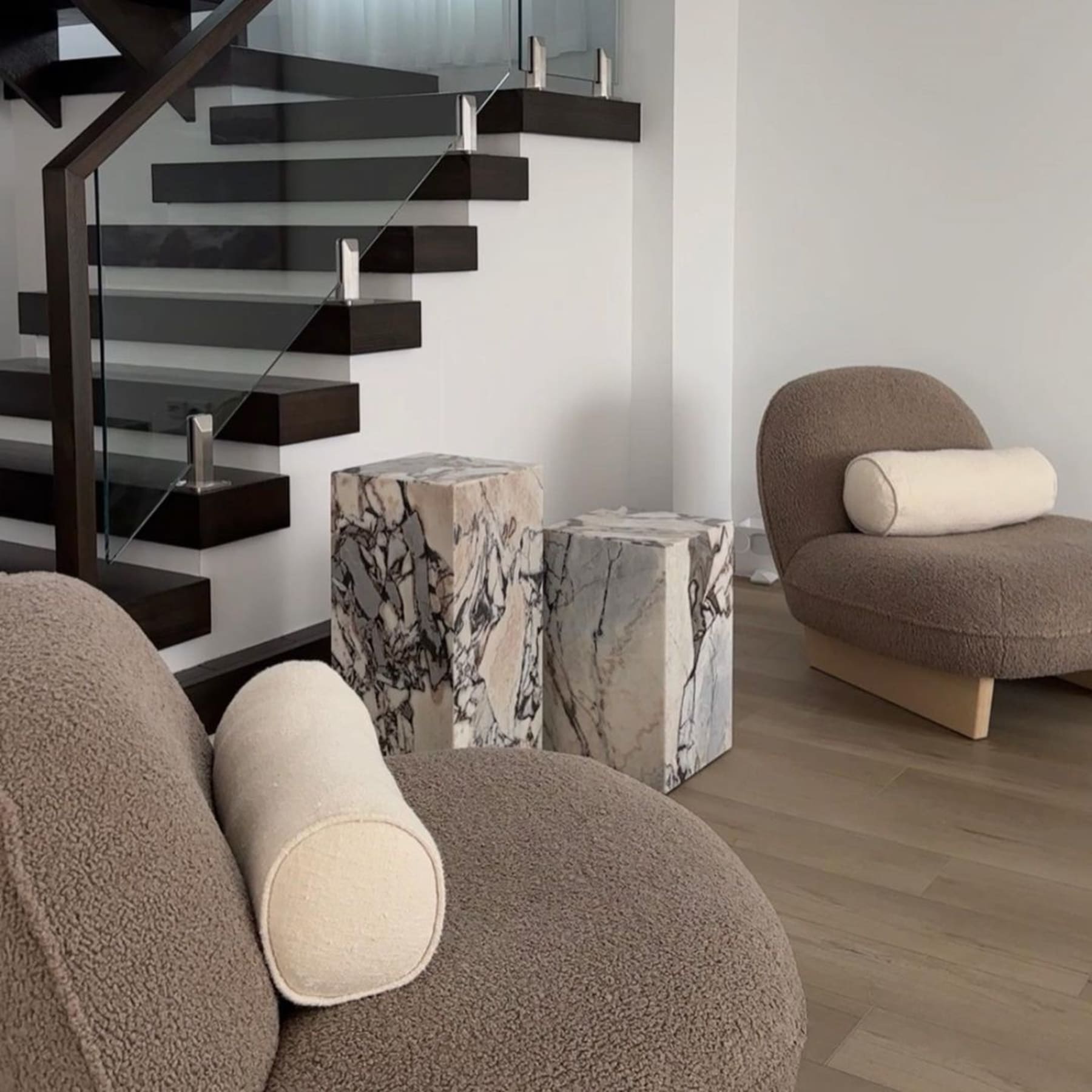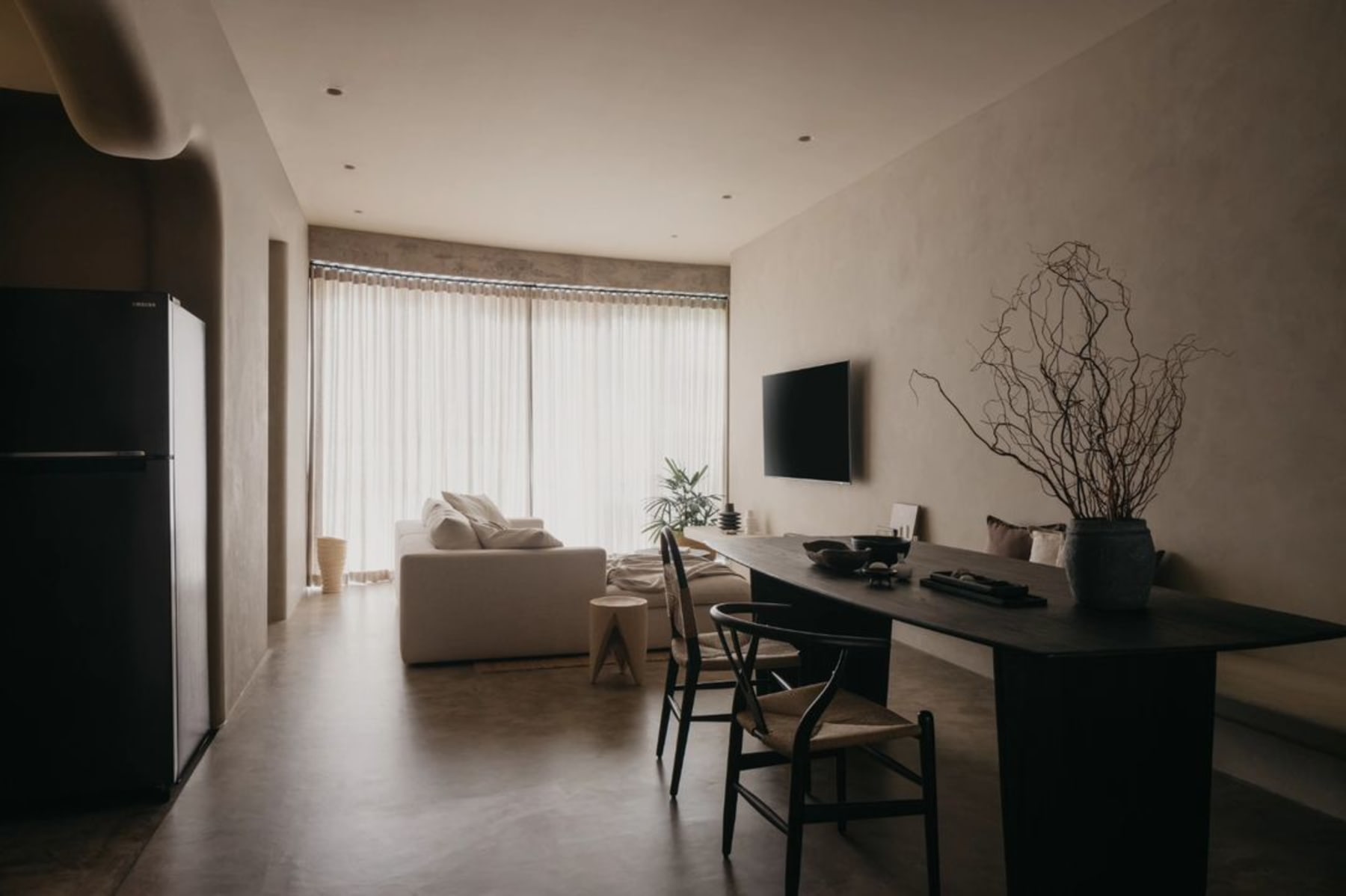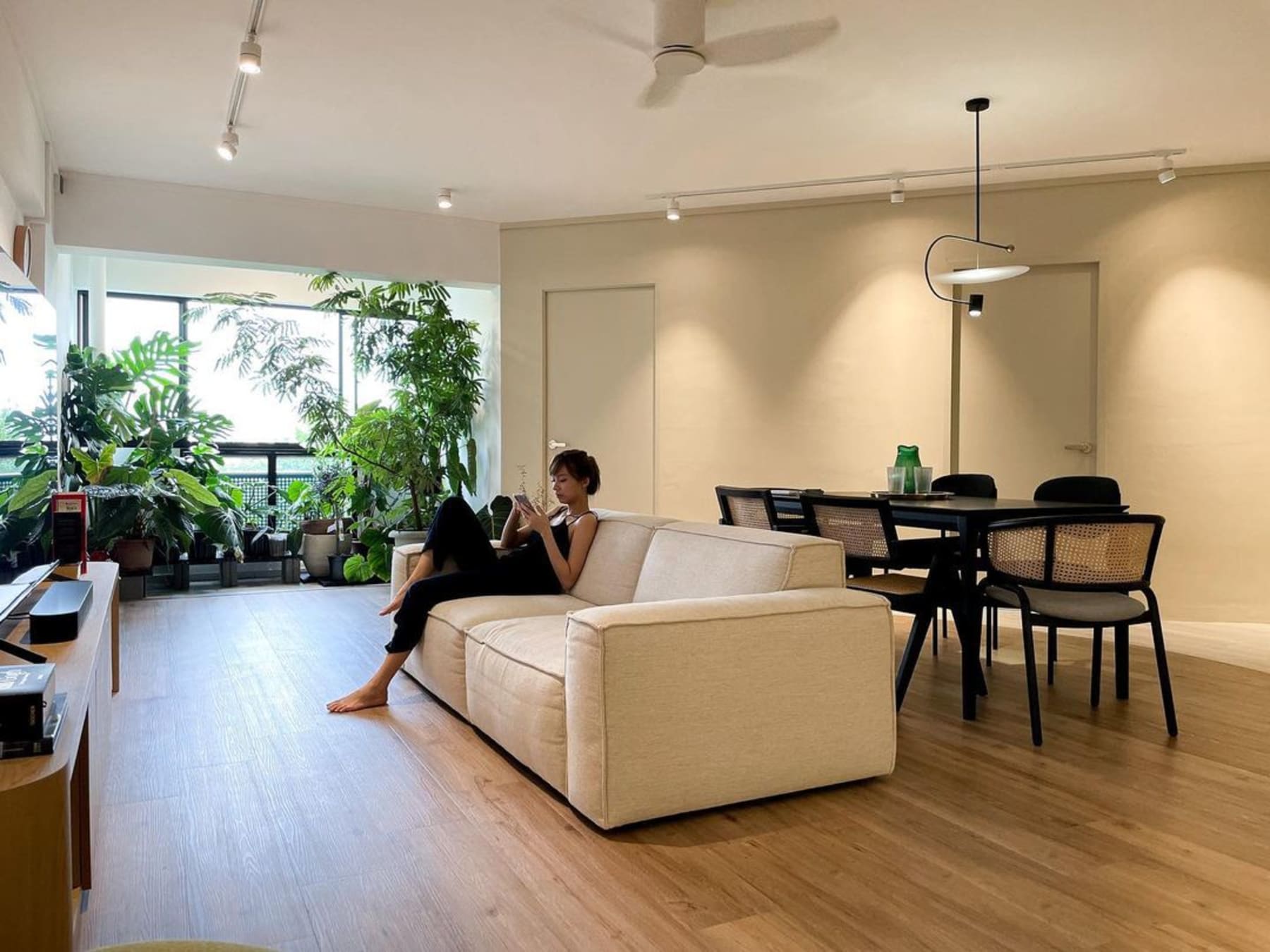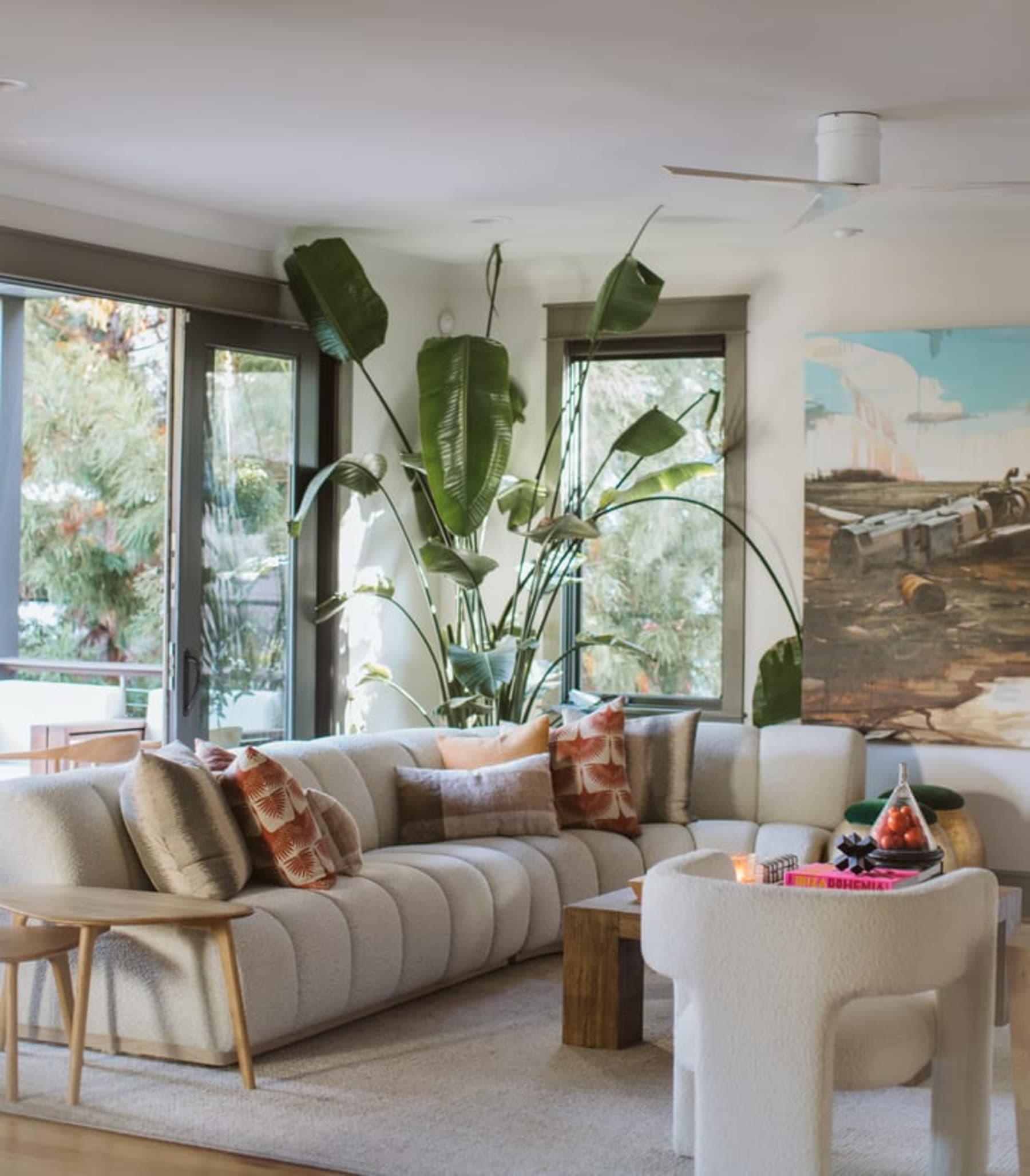
What Is The Organic Modern Interior Style?
When it comes to interior design, styles come and go. But one aesthetic that seems to be captivating homeowners is the organic modern interior design.
Rooted in the marriage of contemporary design and the organic beauty of nature, this style creates a harmonious blend of sleek sophistication and natural warmth. If you’re looking to infuse your living space with a sense of modern tranquillity, the organic modern style might just be the perfect fit!
Let's delve into what makes this style unique and explore practical ways to incorporate it into your home.
What is organic modern style?
This design style seamlessly fuses contemporary aesthetics with the raw, natural beauty of the outdoors. The organic modern style is deeply rooted in modernist design principles while embracing a more organic and natural aesthetic. Think warm colours, modern furniture, natural materials, and most importantly - greenery!

@gohbiggohome creates a harmonious blend of natural and modern elements in the living room. Pictured: The Adams 3-Seater Sofa with Ottoman.
Architect Frank Lloyd Wright first introduced the concept of "organic architecture" as he believed in a harmonious coexistence between sleek, modern elements and organic, earthy textures. His ideas laid the foundation for the organic principles seen in organic modernism.
Some might even say that this style is a beautiful mix of mid-century modern aesthetics, Scandinavian principles, and modern furniture.
Understanding the organic modern design style
1. Nature-inspired elements
Organic modernism draws inspiration from the natural world, emphasising the use of materials like wood, stone, clay, and concrete. Furniture pieces often feature clean lines, showcasing the beauty of organic materials in their raw, unadorned state.
2. Neutral colour palettes
The colour scheme is a key element of organic modern design. Opt for a neutral palette dominated by earthy tones such as browns, greens, and greys. These colours create a serene backdrop that complements the organic elements within the space.
3. Minimalistic approach
Simplicity reigns supreme in organic modern interiors. Embrace a minimalist approach by decluttering your space and choosing furniture with sleek, uncomplicated lines. Allow each piece to stand out on its own, celebrating its form and function.
4. Biophilic design
Biophilic design is a fundamental aspect of organic modern style, aiming to strengthen the connection between the indoor environment and the natural world. Incorporate biophilic design principles into your home to enhance the organic atmosphere - think indoor plants, large windows, and lots of natural light.
These elements not only elevate the visual appeal of the space but echo the beauty and tranquillity of nature.
Incorporating organic modern style into your home
Bring in warmth with wood
Along with stone, wood is another popular material commonly included in organic modern homes as it brings warmth, texture, and a connection to nature - which are the key elements of this design style.
Select pieces with wooden frames or accents. Consider wooden chairs, coffee tables, side tables, or a dining table to introduce the warmth of wood into the living or dining area.

@ovon_design creates a beautiful pairing with the Jonathan Leather Sofa and two wooden armchairs.
If feasible, ceiling beams, flooring, and wall panelling also provide a classic and timeless foundation for an organic modern interior. Incorporate wooden decorative elements such as sculptures, bowls, or vases. These accents contribute to the natural, organic theme while adding a touch of craftsmanship and artistry to the space.
Layer natural textures
Integrating natural textures is a key design strategy, aiming to create a sensory-rich environment that goes beyond the visual. The emphasis here is on selecting materials that evoke the raw, unprocessed feel of the natural world, adding warmth, depth, and tactility to the space.
Layer natural textures in the space like a jute rug, textured throws, and a rattan armchair. Add some woven baskets around the dining area or in the kitchen to introduce a rustic and handmade quality to the space. These elements add depth and tactile appeal, creating a sensory-rich environment.

@wasa.bihome creates a tranquil bedroom with the Dawson Bed, a plush rug, and rattan pendant lamps.
Include stone statement pieces
In organic modern styles, statement pieces play a pivotal role in anchoring the aesthetic and setting the tone for the entire space. And, the use of stone or marble as a centrepiece creates a direct connection to nature.
Whether it's a coffee table, a dining table, or a statement sculpture, using Carrara marble, travertine, or slate reflects the organic beauty found in natural landscapes.

@casa__granada creates a dreamy sitting area with the Ingrid Sherpa Chair and two marble sculptural blocks.
You can also consider incorporating stones as flooring or wall cladding. While this may be a larger undertaking, it can create a cohesive and impactful design statement.
Embrace an open floor plan
Adopting an open floor plan enhances the overall aesthetic and practical aspects of the organic modern style, allowing the natural elements to carry through the entire space.

The living room and dining room blend seamlessly in @studiometanoia’s home. Pictured: The Dawson Chaise Sectional Sofa.
Walls are minimised, creating a sense of continuity between the kitchen, dining, and living areas. This spatial flow promotes a feeling of expansiveness and eliminates the compartmentalised feel of traditional layouts.
Furthermore, with fewer walls obstructing the path of natural light, open floor plans the penetration of sunlight throughout the space - which ties back to the design principles of organic modern interior design.
Fill your home with greenery
The addition of indoor plants is the hallmark of the organic modern style. Lush greenery not only beautifies the space but also brings a breath of nature indoors.
Aside from fostering a sense of connection with nature, plants contribute to the visual interest and diversity of the design palette. The lush greenery contrasts with the clean lines and neutral tones prevalent in organic modern interiors, adding vibrancy and life to the space.

@iamdennislim creates a dedicated area near the balcony for lots of greenery. Pictured: The Jonathan Sofa.
Place plants in different shapes, sizes, and textures to create a dynamic landscape in your home. Large, leafy plants like monsteras or birds of paradise are great options for the living room, while smaller plants like succulents and pothos are good for the bedroom or bathroom.
Incorporate curves and organic shapes
Including curves and organic shapes in your home isn’t just an up-and-coming interior design trend, but one that is a big part of organic modern styles. This key design strategy softens the clean lines and adds a sense of warmth and fluidity to the space.
Sofas with curved arms or rounded backs and coffee tables with elliptical shapes help to soften the overall aesthetic.

@homebyheena opts for the Auburn Performance Fabric Curve Sofa to introduce some curves into the living room.
Architectural features with curved or rounded elements like arched doorways, rounded wall niches, or curved staircases, can also add visual interest to your home.
Add pops of colour
While neutrals serve as a foundational and calming element in the organic modern style, incorporating pops of colour introduces vibrancy, personality, and visual interest. Introduce bold or contrasting colours through accent furniture, decoration, artwork, or rugs.
From earthy tones like moss green and terracotta to bold jewel tones like emerald and sapphire, these colours can be used to create focal points and break the monotony of the space while still creating an organic modern interior.

@bbbuffaloe introduces colour into their home through artwork, throw cushions, and decor. Pictured: The Marlow Performance Bouclé Chaise Sectional Sofa, Paloma Bouclé Armchair in Snow, and Vincent Coffee Table Set in Oak.
Organic modern style offers a refreshing approach to interior design, seamlessly blending the elegance of modern aesthetics with the timeless beauty of nature. By incorporating natural materials, a neutral colour palette, and minimalist principles, you can create a home that exudes tranquillity and sophistication.
FAQs
What’s the difference between organic modern and mid-century modern styles?
While both interior design styles share some common elements, organic modernism is a more contemporary and nature-centric evolution of mid-century modern design. Organic modern style places a stronger emphasis on nature-inspired elements, incorporating organic shapes, textures, and a connection to the natural world.
What are the colours of the organic modern style?
Organic modern style is dominated by neutral colours such as white, beige, grey, and light tones. Neutrals form the backdrop, creating a serene and minimalist foundation for the space.
What are the best materials to include in organic modernism?
This style celebrates a mix of materials that evoke nature such as wood, stone, and natural fibres. The key here is to embrace these materials in their natural form, like weathered wood or chipped stone.